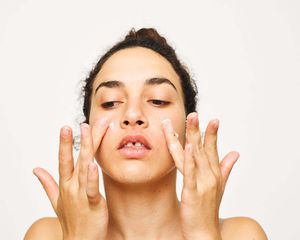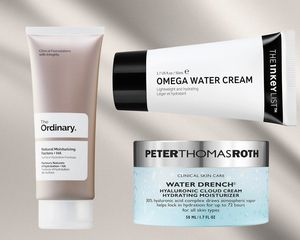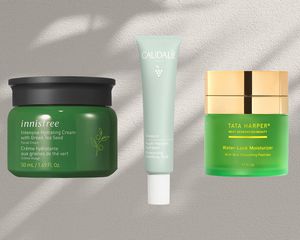:max_bytes(150000):strip_icc()/Stocksy_txp45744f36Vci300_Medium_3031317-8b24bd0ded3e4c2a8be20b048cf6608f.jpg)
Stocksy
Getting enough sleep is crucial to maintaining a healthy lifestyle, but when it comes to getting your "beauty sleep", the right skincare routine can level-up your skin health. According to Parvaneh Rafaeloff, MD—medical doctor at Le Jolie Medi Spa—your skin enters a reparative phase while you sleep, so an effective nighttime skincare routine is crucial. "Additionally, there aren't environmental stressors at night (like environmental pollution and sun damage) while you sleep," she says. "So products are able to better penetrate when you're not wearing makeup while you sleep and the skin can breathe."
So, what exactly are the steps in a simple, effective nighttime skincare routine? Ahead, Rafaeloff alongside dermatologists Dr. Anna Guanche and Dr. Carl Thornfeldt break down the ideal step-by-step evening skincare routine.
Meet the Expert
- Anna Guanche, MD is a board-certified dermatologist based in New York City.
- Carl Thornfeldt, MD, is a board-certified dermatologist and the founder of Epionce skincare.
- Parvaneh Rafaeloff, MD is a physician for Le Jolie Medi Spa.
Step One: Remove Your Makeup and SPF
Anna Guanche, MD, is a big fan of double-cleansing—the idea of cleansing your skin twice at night to get an effective cleanse—and recommends starting off your evening skincare routine by removing your makeup (if you wear it), sunscreen, and oil and debris from the day. She recommends a gentle, non-foaming cleanser for this step, such as a cleansing balm or micellar water. You can also use an oil-based makeup remover with cotton rounds if you wear waterproof makeup.
Step Two: Gentle Cleanser
No matter your skin type, a gentle cleanser that won't strip your skin of natural oil and disrupt your skin's microbiome (read: cause irritation) is essential, says Carl Thornfeldt, MD, practicing dermatologist and founder of the skincare line Epionce. He says sensitive and dry skin types should look for a hydrating cleanser, while oily and acne-prone skin types can opt for a gentle foaming cleanser.
Byrdie Tip
Optionally, you can use a toner after cleansing. However, the dermatologists we've interviewed agree that using toner isn't necessary, especially if you've double-cleansed.
Step Three: Targeted or Spot Treatments
This step is where you can tailor the routine to your skin concerns, says Thornfeldt, whether that's a serum for hyperpigmentation or a prescription acne product like tretinoin. This is also where you put any spot treatments on active breakouts. However, it's important to note that prescription retinoids and spot treatments work best on dry skin, so it's best let your skin dry for about 20 minutes after cleansing before you add treatments with active ingredients.
Most often, targeted treatments are commended to be used 3-5 nights a week, so you can skip this step on your "off" nights.
Step Four: Hyaluronic Acid Serum
Hyaluronic acid is a well-supported, hydrating ingredient that almost anyone can add to their routine—especially if you have dry skin. However, hyaluronic acid serums aren't considered a "mandatory" step in an evening skincare routine. Add it in after your targeted treatment if you can, or look for a moisturizer that contains hyaluronic acid to complete two steps in one.
Step Five: Eye Cream
Eye creams aren't totally bogus—when used as a form of preventative care, they're beneficial because they provide the thin skin around your eyes with a targeted treatment. Some under-eye creams claim to brighten and reduce the appearance of dark circles, however, keeping that delicate area hydrated is what's most important, especially since our under-eyes can go through the ringer with eye makeup removal.
When looking for eye creams, check for formulas that have peptides, which boost hydration and help firm the skin to smooth fine lines and wrinkles.
Step Six: Always Moisturize
Every skin type should end their evening skincare routine with moisturizer, even if your skin is oily or acne-prone. Thornfeldt recommends a "skin barrier–repairing moisturizer to help rejuvenate the health of the skin." In other words, choose something hydrating that won't clog your pores. We're fans of products that contain hyaluronic acid because it helps your skin retain moisture. If you skip this step, your skin might feel tight and very dry, unable to reap the benefits of a good night's sleep for your skin. If you're concerned about breakouts, opt for an oil-free formula that still replenishes your skin with the moisture it needs without adding excess oil to your pores.
Step Seven: Optional Face Oil or Occlusive
While completely optional, those with dry skin will benefit from sealing in their skincare routine with an occlusive product such as a face oil (or "slugging" with good old-fashioned Vaseline). Occlusives like these trap the moisture into your skin, resulting in deeper, more effective moisturization. However, occlusives aren't recommended if you have acne-prone skin, nor are they recommended to layer on top of retinoids, as "trapping" the retinoid can cause irritation.





